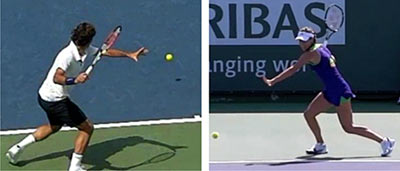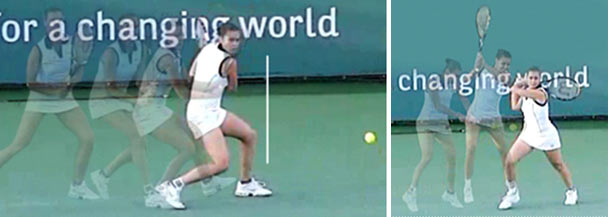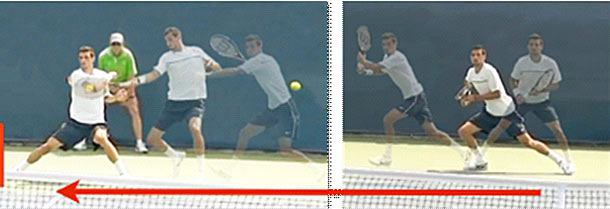| TennisOne Lessons How the Tennis Gods Move Coach Dan McCain Movement is the key to every great stroke. It is the secret to every great shot. It is everything that happens before, during and after each strike of the ball. Todd Ellenbecker, the Director of Sports Medicine for the ATP World Tour said that "Footwork forms the framework of any great player." In a game where accurately hit ground strokes travel up to one hundred miles per hour with up to four thousand rpm's of spin, time is of the essence. Players with consistently more time and composure to hit the shots they want in any situation are most likely to succeed. "It is much more important than ball striking, that's for sure," three-time French Open champion Mats Wilander told Greg Garber of ESPN. "Usually, the best players in the world are the best movers."
At the 2014 USPTA Coaches Convention in Minneapolis, former Tour Manager for the ATP and current USPTA Director of Coaching Education Fred Viancos said this about professional tennis: "The difference between good players and great ones — is that when the top players are really on the move, their strokes still hold up. When everyone else is on the move with less time over the course of rallies — they're strokes break down. But the great ones never break down, even when they are on the run with almost no time." Decades ago the LTA developed the BIOMEC Model to enhance player and coaching development. BIOMEC is an acronym for biomechanics (the study of human movement) and the model defines principles of muscle movement, forces, energy transfer, momentum, and how the laws of physics apply to a tennis player. The first letter in the LTA born method, "B," stands for Balance. Ellenbecker echoed Viancos in a Matt Fitzgerald piece on AtpWorldTour.com about movement in pro tennis. "There is so much movement involved in tennis and you have to position yourself optimally. The best players are able to get to the greatest number of shots in a prepared, balanced way." Former ATP Top 10 player (and former coach of Andy Roddick, Andre Agassi and Andy Murray) Brad Gilbert told Greg Garber of ESPN that "The most important things in movement are balance and efficiency." Maintaining balance in tennis remains a mystery for many players, regardless of their level of play, particularly when they are forced to run in various directions to receive heavy, penetrating shots. Their strokes, as Viancos put it, don't hold up. In biomechanics, balance is the ability to maintain the line of gravity (vertical line from center of mass) of a body within the base of support with minimal postural sway. Dynamic balance is the ability to do this on the move. For the tennis gods of today, the quality of their balance in the backcourt has much to do with their preparation, posture and momentum. On court one day in the summer of 2013, I asked former South African Davis Cup player Izak Van Der Merwe what he thought was the biggest weapon in pro tennis at the time. "Andy Murray's split step," he replied. At the time, Murray had won Olympic Gold and 2 Grand Slam titles inside a year. "It has a lot to do with his anticipation. He often lands his feet in a certain way so he can turn and explode toward the ball. His first step is incredible and it just seems like he has more time than everyone else right now." The fluidity and speed of a player's first step can determine the amount of time and composure that player has upon arriving to the ball to hit the shot. Great movement preparation facilitates great posture and thus balance. The split step lightens one's body weight and provides maximum time to move to the ball. Jack Groppel called this "unweighting," because it lightens a player's body weight and facilitates a quick first step. With the immediate unit turn thereafter, players like Murray above and Kei Nishikori below can quickly turn and run to the ball with fluidity, composure, and good posture.
Loading also has significant effects on dynamic balance. Once the tennis gods generate a great deal of momentum in the back court by moving explosively to a shot, they often need to slow that momentum down — just enough to gain the poise needed to execute their stroke technique. Often just after a series of small adjustment steps, the tennis gods "load up," or coil their upper and lower body muscles before springing into their shots. As a result of players like Federer and Ivanovic below loading well for a ground stroke with the trunk and legs, poise and posture often improves prior to releasing energy into the ball. USTA Managing Director of Coaching Education and Sport Science Paul Roetert said that "Keeping the center of gravity in line with the base of support gives optimum balance, and lowering your center of gravity makes you more stable."
"Obviously when you are at one end of the court and have to sprint to the other side, covering the longest distance of the court, you have to take several large steps to even begin to move to the ball. But once you get closer to the ball, that's when you see players taking these small transition steps to fine tune the position. These are so important to a player's success in a rally. A majority of the shots (on the tour) are a meter or two on either side of us, so that's why these smaller steps are so effective. Players are changing directions several times within a point, so the little steps help with maintaining balance," said Ellenbecker. The multiple exposure (below left) shows these adjustment steps in action before the 2015 US Open champion Flavia Pennetta loads into an open stance for her two-handed backhand. Using the momentum she gained moving laterally across the court also helps Pennetta maintain balance on this backhand (below right). Moving laterally through the shot enables her feet to stay under her, so her back can remain relatively straight, her head can stay still, and she execute her stroke with poise and precision. The same can be said for the Djokovic strokes in the video above.
Linear momentum relates to Isaac Newton's law of inertia (part of the BIOMEC Model), which states that bodies in motion will stay in motion, moving along the same path unless disrupted by an outside force. So when a player gains momentum by preparing and moving to a receive shot, the quickest way to get there would be to move to in a straight line. Whatever direction a player moves to the shot, to use momentum effectively means to move through the shot in that same straight line.
Moving to his right, Djokovic's right leg (above) loads into an open stance, planted behind the baseline and the singles sideline. As he drives his racquet head through the ball, he continues moving to his right. This use of momentum enhances power generation for the Serb on this forehand. It facilitates the rotation of his shoulders as well as the time and space needed to execute his out in front contact point. Finishing with his feet squared off to the court, his right leg puts on the breaks of his body in motion behind the baseline and the doubles sideline. From a balance perspective, using this linear momentum helps him maintain good posture because his feet remain under his center of gravity before, during, and after he drives through the ball. It also grants him the immediate ability to recover in balance back to the middle of the court thereafter. The horizontal path of his body in motion continues flowing to his right before, during and after he impacts the ball. Even though his momentum does not travel forward toward the net, it makes him able to fully thrust his body weight into the ball. This serves as an incredible power source. Like Djokovic, Grigor Dimitrov (below) finishes his stroke with his right foot on the outside as we can see below. This move helps him execute one of the key ingredients of forehand technique: trunk rotation. After he loads his right leg into an open stance, he allows his right foot to lift up off the ground to facilitate his lateral momentum. Along with using an open stance in this situation, moving through the shot gives Dimitrov the time and space to rotate his shoulders nearly one hundred and eighty degrees.
As a result of Dimitrov's shoulder rotation, his hips open up to face the court as his strings drive into the ball. This makes it possible for him to impact the ball well out in front of his body. His ideal contact point provides him the chance to extend his arm up through the hitting zone, creating another added power source in the leverage with his arm and racquet. Because his shoulders can fully rotate before, during and after impact, he can easily accelerate his racquet head up through the ball. With his shoulders fully rotated and his chest facing to his left upon his finish, he can naturally follow through with the racquet head over his left shoulder. This allows for a relaxed swing path and finish with his arms, which enable effortless, injury-free movement and technique. With his right foot finishing out to the right side of his body, he stops his momentum after completing his stroke. His right leg digs into the ground, putting on the brakes so he can quickly recover back to the middle of the backcourt on balance.
Not only did this momentum aid Dimitrov in generating power, it helped him maintain dynamic balance because it allows him to keep his feet under his center of gravity and therefore maintain good posture. It gave him time and space to rotate his shoulders, which then helped him execute an ideal contact point and follow through. Since his feet our squared off to the court as he puts on the breaks, this linear momentum also immediately helped him get ready for the next shot on balance. Dimitrov's momentum influences his shot selection here as well. His confident movement and mechanics make him more willing to select a neutral or even somewhat offensive shot in this situation. He can do more with this forehand and look to hurt his opponent within the rally because he knows he will have the balance, trunk rotation and power to do almost anything with the ball. He also knows he will have the time and speed to recover for the next shot in the point, further granting him the opportunity to hit an explosive shot even though he finishes behind the deuce side doubles alley. Dimitrov has hit forehands clocked at speeds approaching one hundred miles per hour during his career. Striking forehands (like this one) with such astounding power perhaps helped him gain the nickname, G-Force. By defining what it means to maintain dynamic balance, coaches and players can more effectively train. Developing habits that promote balance on the move gives players confidence in their ability to produce clean shotmaking in almost any situation - even defensive ones. Keeping good upper body posture, loading, and manipulating momentum can serve us all as core concepts to develop dynamic balance.
Daniel McCain Daniel McCain serves as the Director of Tennis at the Cavalier Golf and Yacht Club in Virginia Beach and also as Tester for the PTR. McCain formerly served the USTA as the Manager of Player Development after 7 years of coaching Division 1 NCAA college tennis. He also served as the Director of Tennis at the Higueras-Gorin Tennis Academy and traveled with numerous players on both the WTA and ATP Tours. He is the author of Building a Champion, The I Formation, and Momentum and the 2015 released book How the Tennis Gods Move. This article by Daniel McCain, is based off of a chapter in the 2015 released book How the Tennis Gods Move, which is available on Amazon. |


